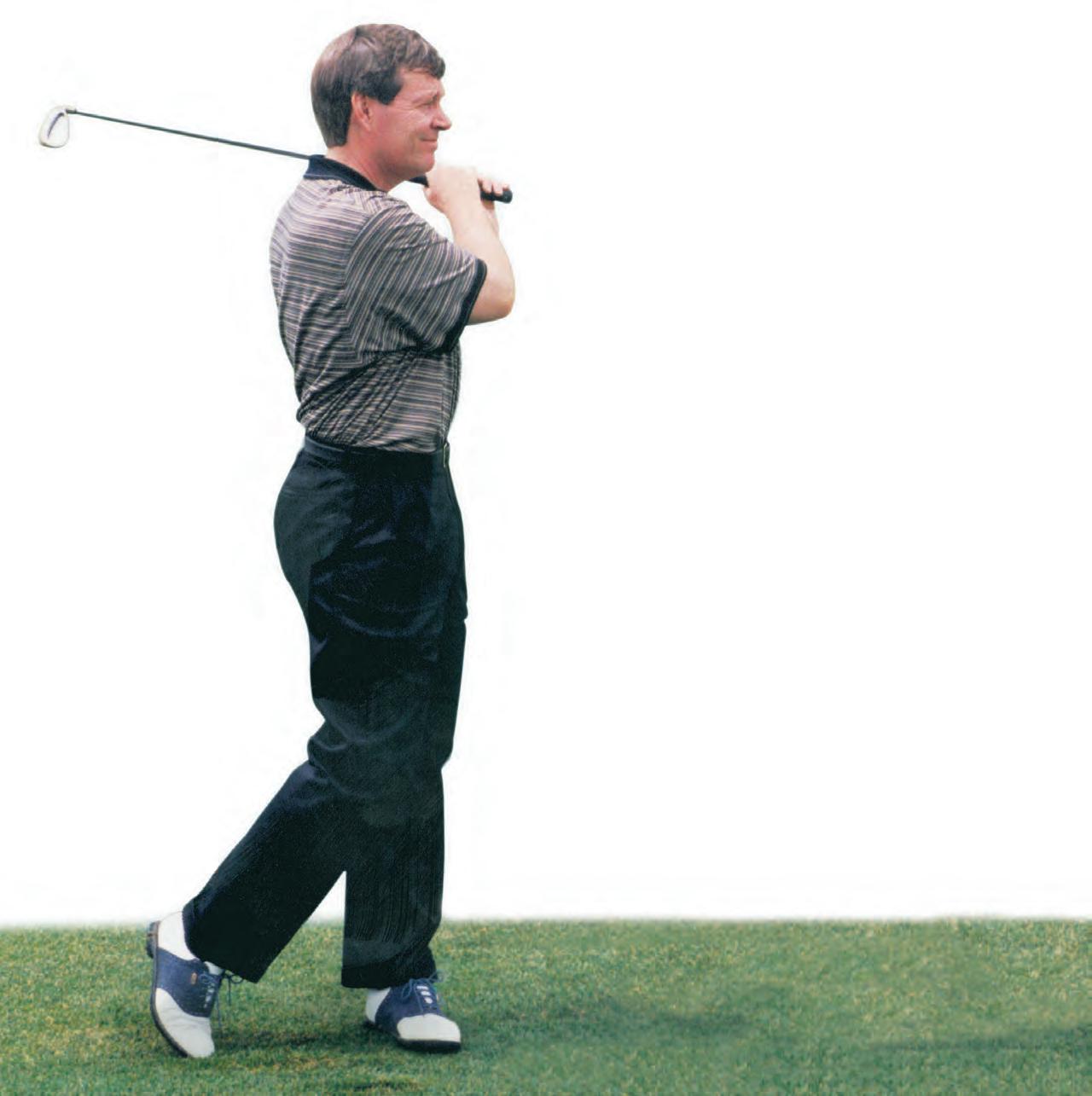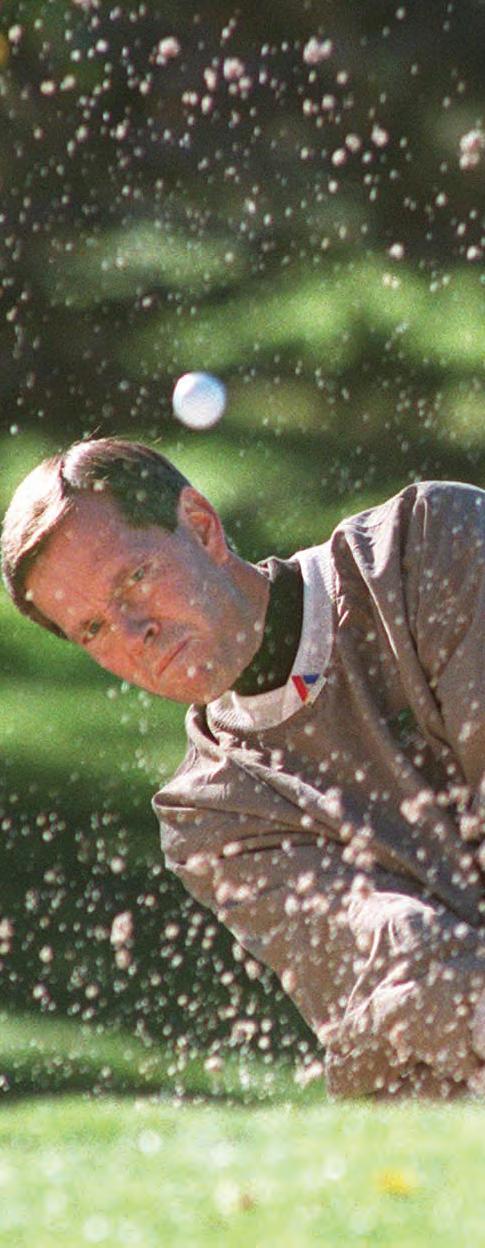
14 minute read
Staying Healthy as Governor
from Real and Right
In my sixteen years of public service, the time missed because of sickness or medical issues is almost nil. Yes, occasionally I’d get a nasty cold or have the flu, but given the number of hands I shook every day and the public places I navigated, one can only conclude that I must have developed world-class antibodies. For the most part, I was able to work through such episodes or work remotely for a few hours. Overall, I was enormously blessed with good health.
Migraine Headaches
However, there were a few health issues I’ve still had to deal with, one of them being migraines. Since I was fourteen years old, I have had periodic migraine headaches. They typically occurred two to four times a year, though fortunately the frequency has subsided as I’ve gotten older.
My migraines are characterized by the full range of typical symptoms recognized by any migraine sufferer. I can always tell when a migraine headache is coming on: The first signal is flashing lights within my visual field. It’s like they are perceived, not explicitly seen. Then there is a period where my vision is incomplete. For example, I can look at a license plate and while I know there are letters and numbers, I can’t make sense of them. My capacity to formulate sentences also begins to degrade. Generally, I then move into a period of nausea and intense pain. While sometimes medication helps, other times it does no good. Experience has taught me that when the signals start, I have about forty-five minutes to get to a dark place with an ice pack and pillow over my head. If I hadn’t been through it so many times it would be quite scary.
Overall, I was enormously blessed with good health.
For four to six hours the pain is an intense throbbing along the forehead, inside my eye sockets. The pain slowly subsides into a general head throb. By the next day, it feels what I imagine a hangover to feel like. Within twenty-four hours I’m back to normal. A full-blown migraine will cause me to be out of commission for eight to twelve hours.
In the summer of 1993, I had a migraine episode. A doctor friend of mine had suggested a new medication and I was more than willing to try it. He also suggested a sleeping pill to help me just sleep through it. So, I went to the living quarters at the mansion and took the medication as directed.
Either the combination of the medicines was bad or the dosage was wrong, but it simply knocked me out. I slept the rest of that day and through most of the next one. Apparently, I woke up periodically to eat, but I have no memory of it.
Finally, the third day, I woke up early, resolved to go about my normal schedule because I had a big day of activities, including meetings at the Capitol, a speech to a water-use group in Delta, and a ninety-minute appearance before the student body at the BYU Marriott School of Business.
I have very sketchy memories of that day. I remember deciding to walk from the Governor’s Mansion to the Capitol in an effort to clear my head. What I don’t remember is the speech I surprised my staff with on water being the “most important issue we were facing today.” Nor can I remember a word of the ninety-minute interaction I had at the Marriott School. Apparently, the Marriott School appearance provided a pretty good speech. However, the medication was still in my system and affected my short-term memory. Luckily, by the next day I had returned to normal. Two things should be said about the experience: First, it was the last time I ever took that medication. Second, members of my staff that were with me still tease me about the “Water is Supreme” speech.
Sleep Apnea
Early in my second term in office, I began to feel a lot of fatigue. I felt emotionally and physically depleted. I was also feeling less patient and found myself responding to things in a way that was uncharacteristic of me, and noticed that many mornings I would wake up still exhausted. In addition, I often found my wife sleeping in another room. She said it was because of my snoring.
I began to research these symptoms and concluded they were classical signs of sleep apnea. I went through a sleep study and the diagnosis was confirmed.
Sleep apnea is a common condition. When the brain goes into REM or deep sleep, the soft pallet relaxes but leaves enough space for air to get transported to the lungs. In a person with sleep apnea, the air is closed off, and within thirty to forty-five seconds the brain is signaling, “Hey buddy, wake up—I need oxygen.” While I wasn’t becoming conscious, my brain was going through this cycle over two hundred times a night. No wonder I was exhausted when I awoke. The feeling of depletion I was feeling was a function of sleep deprivation.
Gratefully there was a solution, a fairly simple medical device called a CPAP. It simply blows some air against the soft pallet, keeping it from collapsing over the airway, allowing the wearer to sleep without interruption. It made a big difference in my life and I began to feel much better. Since that time, I have worn a CPAP every night. I carry it wherever I travel.
I have since become a real zealot on the subject of sleep health, and while I was Secretary of Health and Human Services I promoted sleep health and did what I could to drive additional research. I played a role in getting additional technology approved by the FDA. I mention this in my history, primarily because the condition clearly has a genetic connection. My father has it, as do a couple of my brothers. It is a life-altering condition with an easy solution.
Weight Management
While not the primary cause of my sleep apnea, weight gain was a contributing factor. I fought this battle throughout my time in public service—and since. It is easy to see the evidence in pictures taken during this period. During my time as governor, my weight varied by as much as thirty pounds, and I made the cycle more than once. However, I kept working at it, and with the exception of two or three periods when my weight crept up, I maintained a fairly steady range.
While modulating my eating patterns was a primary component of the struggle, keeping a good exercise regimen was also important. I had to vary my routine to achieve regularity. One of my favorite modes of exercise was walking. For several years, I would calendar a walk in City Creek Canyon or to Ensign Peak. To make it productive, I would schedule to have a staff member with me or invite a person who was looking for an appointment. The news media picked up on this and did a few stories on the governor’s power walks. It became a quasi-status symbol to be invited along. Having someone come along made the time go by quicker for me and I enjoyed the change of pace. The security detail always came along and I think they enjoyed it too. The Ensign Peak climb was serious exercise.
When it got cold, I would turn to indoor exercise, usually in the mornings at a gym. At one point, I started going to the Alta Club in the morning about 6:30 a.m. I worked with a personal trainer several times a week and then would reward myself with a short massage. I would stay at the club for breakfast, read the paper, and then dress for work. I would not schedule my first appointment until 9 a.m. It was a great routine, and I ended up doing a similar pattern when I was secretary at Health and Human Services
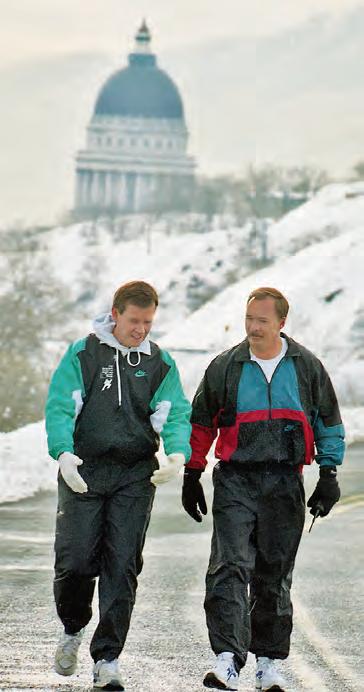
Golf Therapy
My most passionate hobby and exercise during the time of my service was golf. Simply stated, I love golf. It is hard to overstate the amount of pleasure the game has provided me over the years. It is not only a form of exercise; it is the best mental diversion I have. Golf is one of the very few activities I engage in where I am able to stay in the present.
Often when I get into to bed at night, I will reconstruct my last round of golf shot-by-shot. The diversion causes my mind to shift into another gear and I can fall asleep.
Looking back over my schedule for the years I served as governor, it is clear to me that I did not deprive myself of playing opportunities. I have a lot of friends that play golf and we worked at finding ways to get out.
Historically, most of the country clubs in Utah grant the governor some kind of special playing privilege. So, I was able to play most of the better courses in Utah. I frequented Jeremy Ranch, Oakridge, and the Salt Lake Country Club the most. I chose those clubs because they were convenient and I loved the courses. I have friends that play each of them as well.
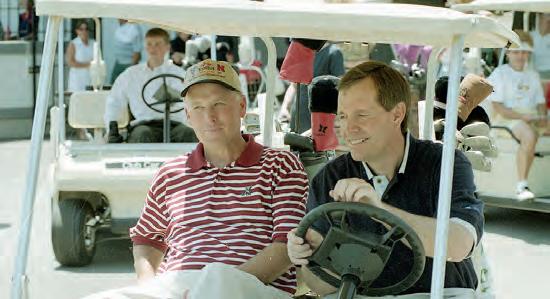
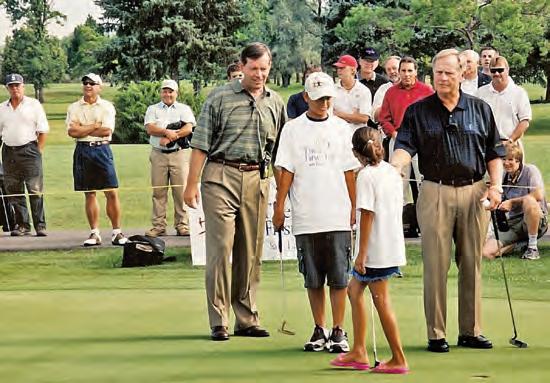
Typically, I would play at the end of the day during the summer when the days are long. I adore playing golf in the evening when there is nobody else around. I would take one of my sons with me or just go by myself for some solitude to unwind. I would start around 6:30 or 7:00 p.m. and play what I called “fire drill golf.” I could play nine holes in forty-five minutes easily that way.
One late summer evening, Rich McKeown and I had slipped out for nine holes at the Salt Lake Country Club. We were on the seventh tee. I hit a perfect drive, right down the center of the fairway. Previously, I had noticed a group of kids sitting on the back lawn of a home that abuts the course. Suddenly one of them bolted across the fairway, picked up my ball, and ran off. The rest of the children scattered as well.
So, I drove to the spot where my ball had been and dropped another one so I could continue playing. As we stood on the next tee, I noticed the boy and his friends had reassembled. I hit my drive on the eighth hole and then quietly slipped back around and drove up to the group in a way they wouldn’t notice. Then I simply drove up behind the kid who had grabbed my golf ball without him seeing me. When he turned around, he knew he had been caught. I said, “So, would you like me to autograph that ball?”
Long pause.
Fourteen-year-olds can get away with that kind of thing.
I was often invited to play in various charity tournaments during the summer. I especially looked forward to the pro-am that accompanied professional tournaments. Somehow the governor always drew a good player as a partner, and I played golf with some of the most notable personalities in golf history.
I played one year with Arnold Palmer as my pro-am partner at a senior tour event at Park Meadows golf course. He is such a wonderful guy, personable, kind, and fun. At one point during the round, I hit into a sand trap and Arnold Palmer noted something about the way I was navigating it that provided an opportunity for him to teach me. He got down in the trap with me and gave me a short lesson. When we were done, he grabbed the rake and started to rake the trap. I protested, but he said, “Let me do it.” I have to admit I have enjoyed telling people that Arnold Palmer raked my sand trap.
One additional story about my round with Palmer: We won the tournament! It was great fun. The next day, I couldn’t play but I ran into to him at an event surrounding the tournament. I said, “Mr. Palmer, I guess you know we won!” He replied, “I know, I loved it… I haven’t won in a long time.”
Another year I played with Lee Trevino. He had a saying for every situation. I remember a compliment he gave me—whether deserved or not—that was memorable. “Governor,” he said, “that swing was a smooth as Dairy Queen.”
I also played with Johnny Miller multiple times. He is a golf genius, and always teaching. One memorable conversation I had with him stayed in my memory. We were talking about Tiger Woods, who was just emerging as a dominant young player. Johnny said, “Tiger’s swing puts such torque on his knee and back that there is no way he isn’t going to have physical trouble at some point.” Johnny called it. Years later, that is exactly what happened to Tiger.
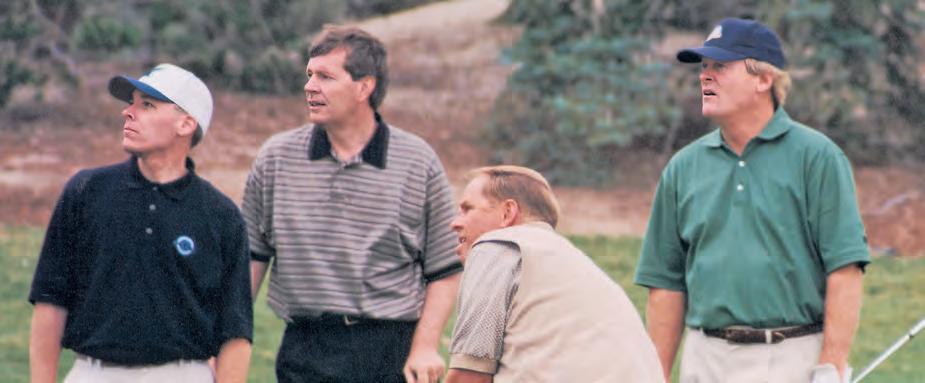
Governor, that swing was as smooth as Dairy Queen.
I didn’t always get the best players in pro-ams. Hot Rod Hundley, the Utah Jazz broadcaster, would host a celebrity tournament. He recruited former and current NBA players to come as celebrities, and each foursome was assigned a celebrity. On the first hole, I complained to one of the other players in our foursome that somehow, we didn’t get a celebrity. My partner said, “Governor, I have bad news for you. It’s supposed to be you.” We both felt cheated.
I was able to play some wonderful golf courses as governor. I played Pebble Beach, Cypress Point, and Torrey Pines.
One night I was at a dinner in Salt Lake City honoring Steve Wynn, owner of the Mirage Hotel and Casino in Las Vegas. He had made a large donation to the Moran Eye Center at the University of Utah. During dinner he asked if I would like to play his golf course. I had heard about his golf course— Shadow Creek in Las Vegas. It is one of the most exclusive courses in the world, made available only to his friends and important customers of his hotel and casino. I told him I’d love to play and he gave me instructions on how to arrange to play on it.
For the next couple of years, after the legislative session was over, I would arrange to take some time for an outing at Shadow Creek. A couple of times I took my son Mike and his friend Ben Curtis. Other times Charlie Johnson came along, and once my brothers Mark and Eric came with me.
Golfing at Shadow Creek is unlike golf anywhere else I’ve played. First of all, it was a spectacular course, literally carved out of the Nevada
desert. The trees were imported as mature palms from a tree farm. (Wynn bought the entire farm for that purpose. They transplanted more than ten thousand trees I’m told.) The water features were like the fountains at the large hotels, with artificial rocks that looked like the real thing. Birds and wildlife abounded.
When you stopped for lunch, there was no menu. You just told them what you wanted. It was rare to see another foursome on the course; back then it was reserved for the high-rollers who spent hundreds of thousands of dollars per visit at the casino.
I came to understand how unique the experience was when I had a conversation with Governor Bob Miller of Nevada. I stopped once to see him while I was in Las Vegas, and he asked why I was there. I told him about playing Shadow Creek the previous three days. His response made me feel a bit conspicuous. He said, “You asked Steve Wynn to play Shadow Creek three days in a row?!” His expression said it all.
